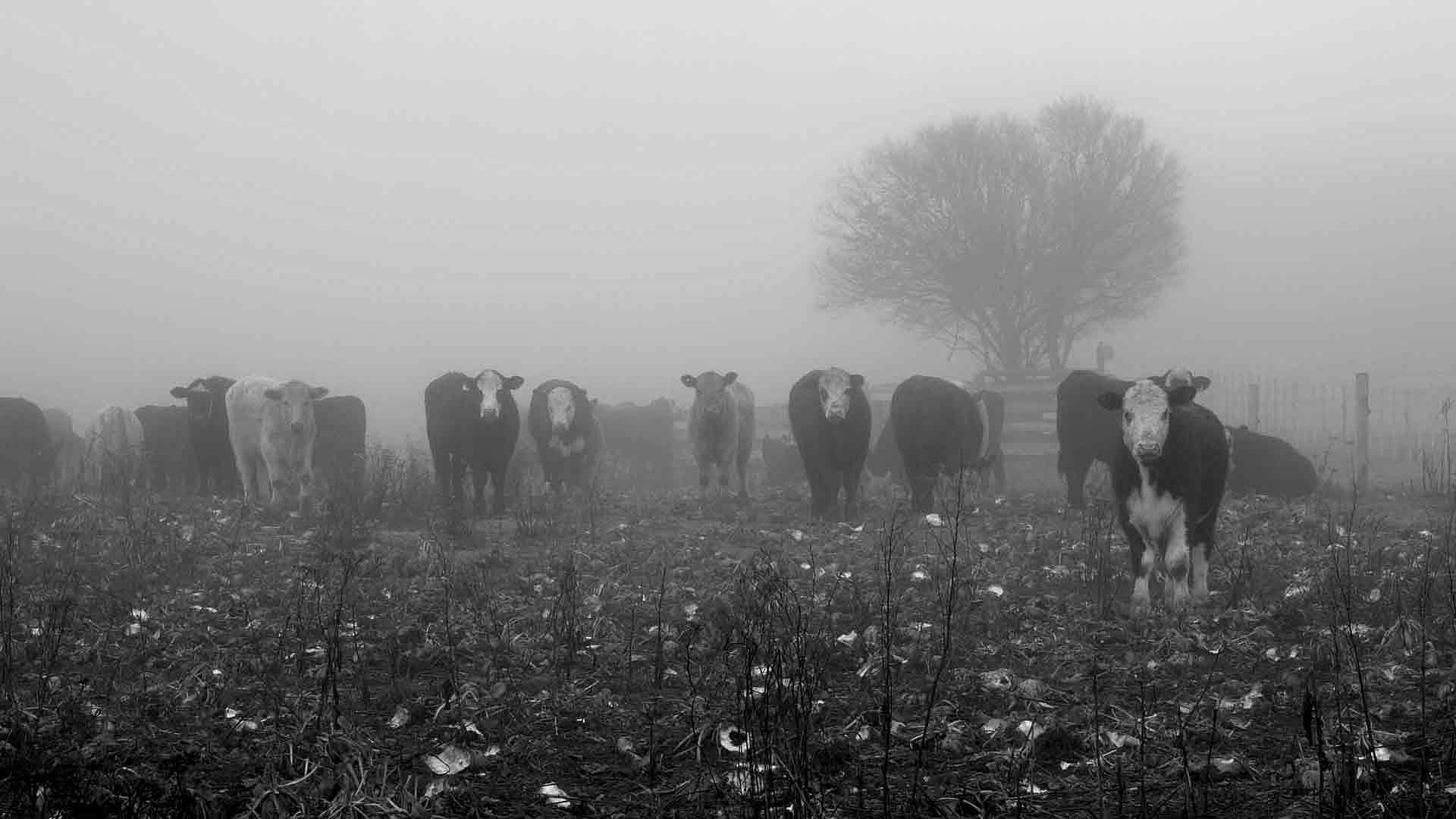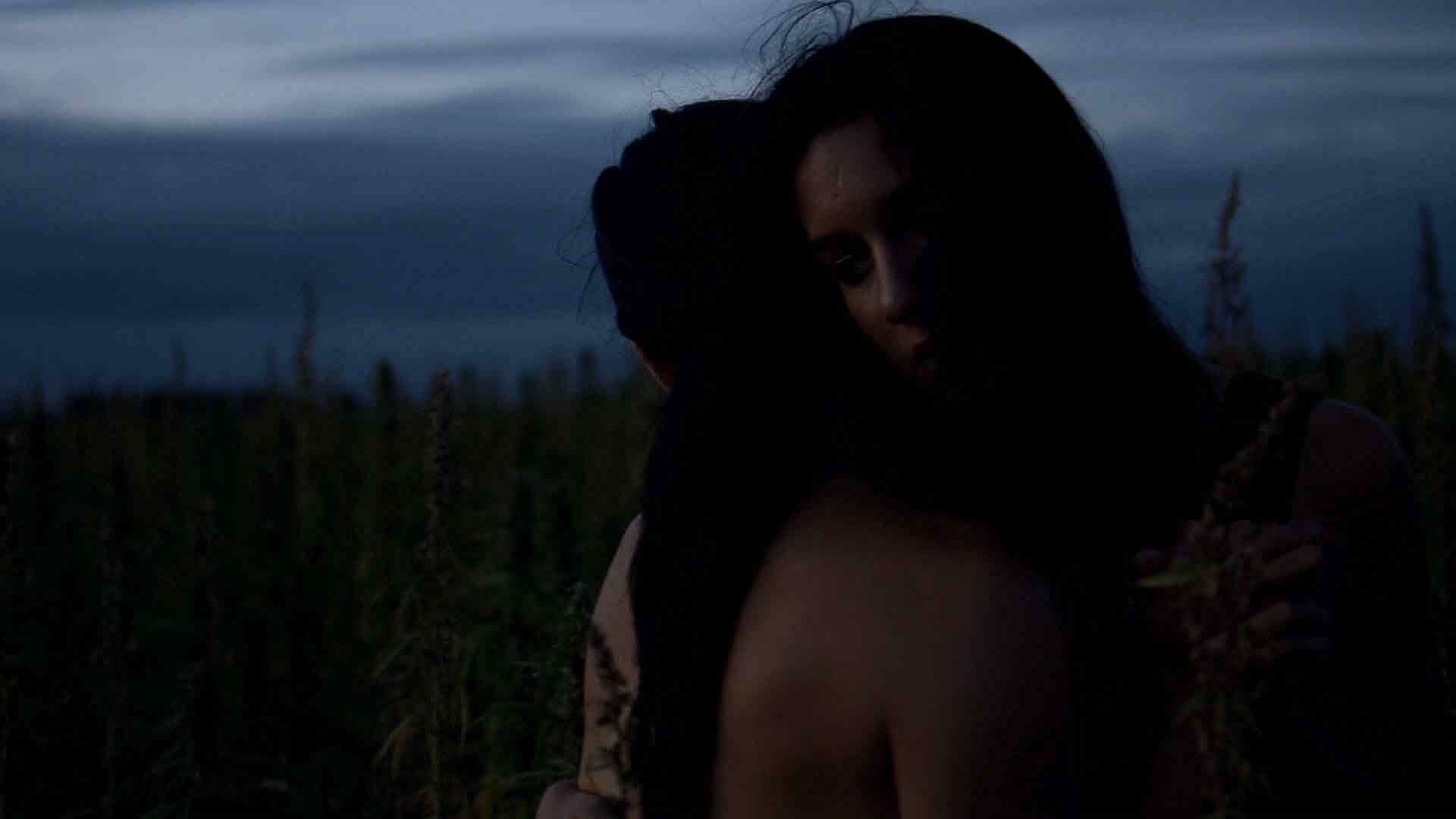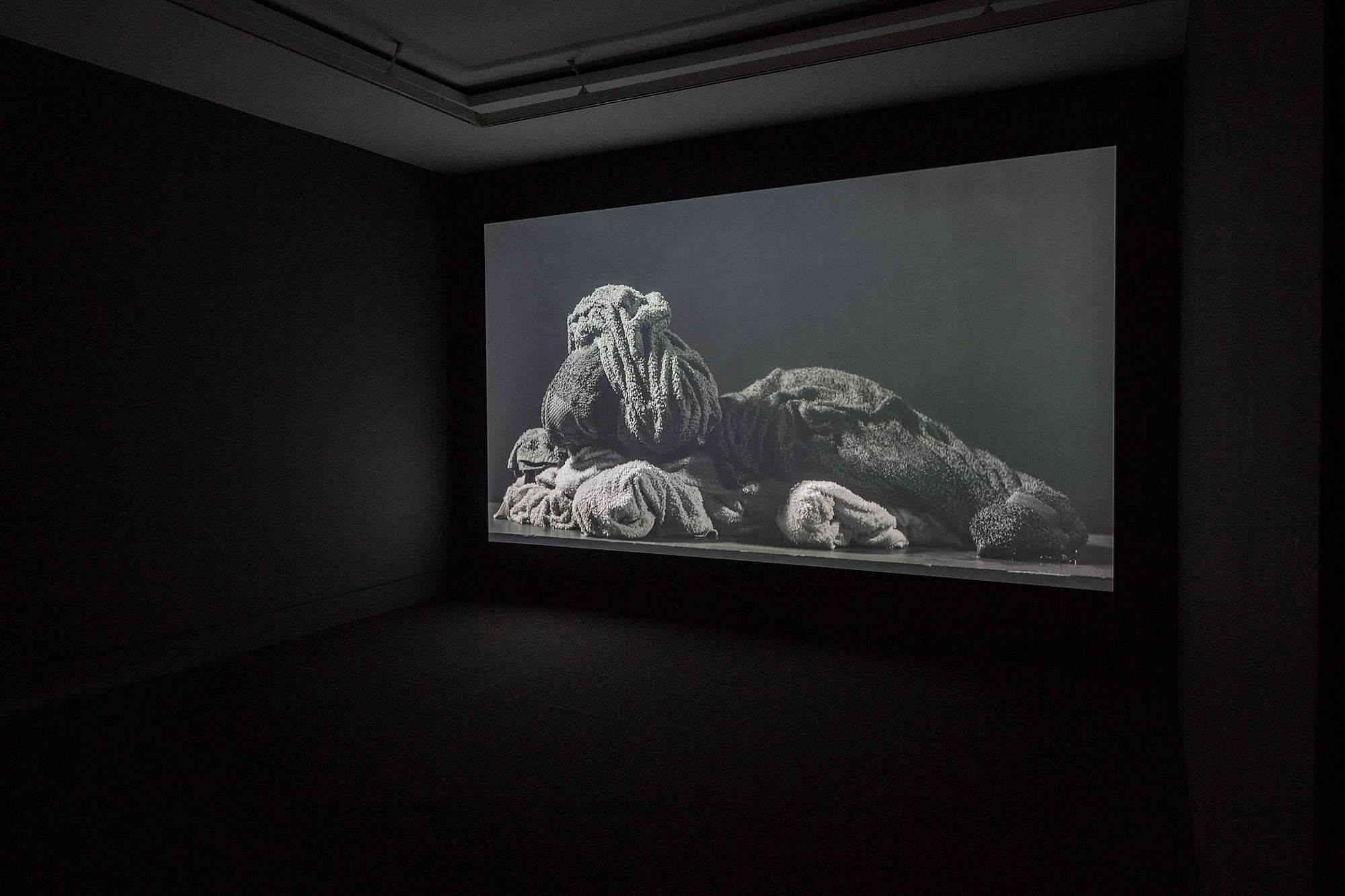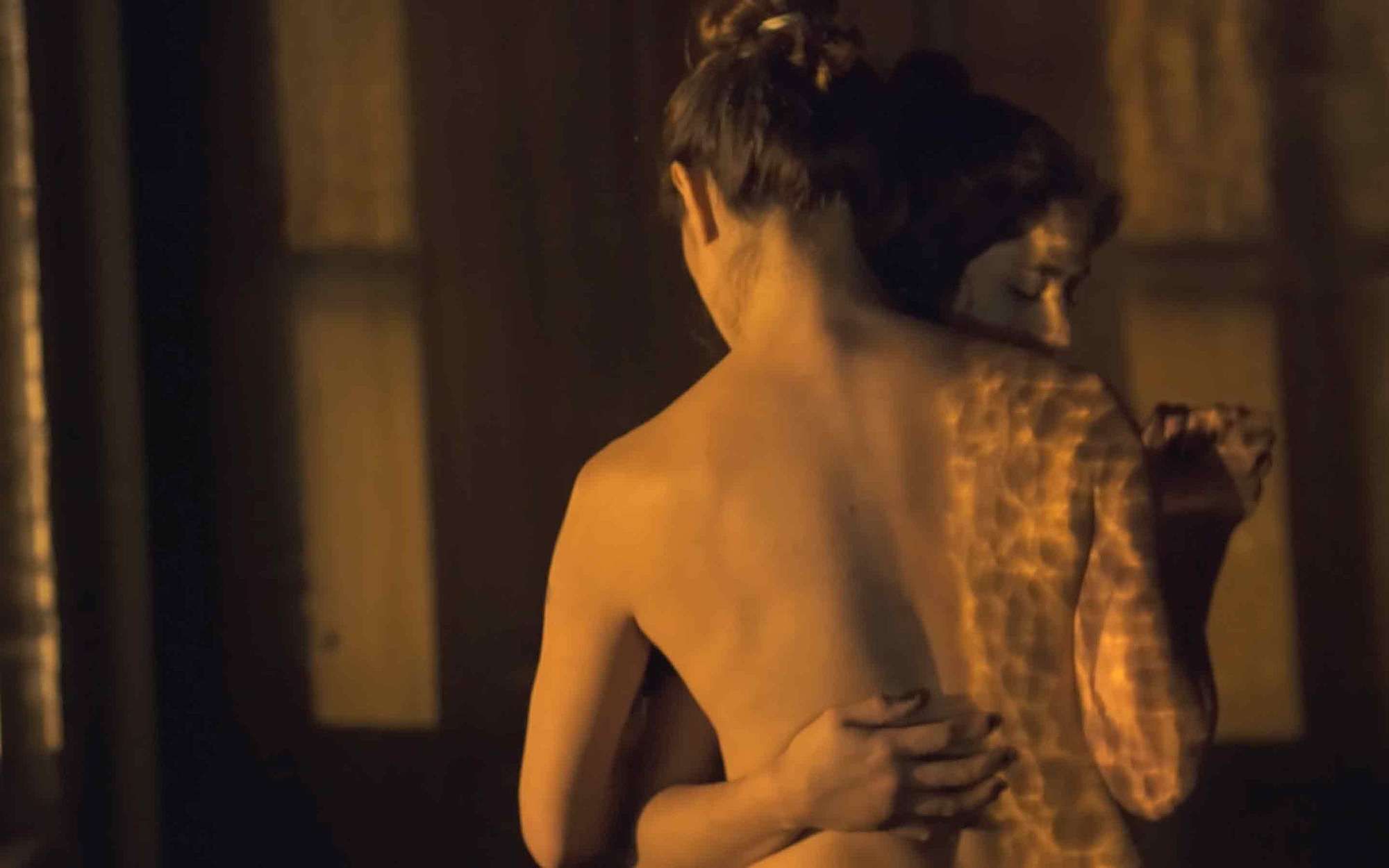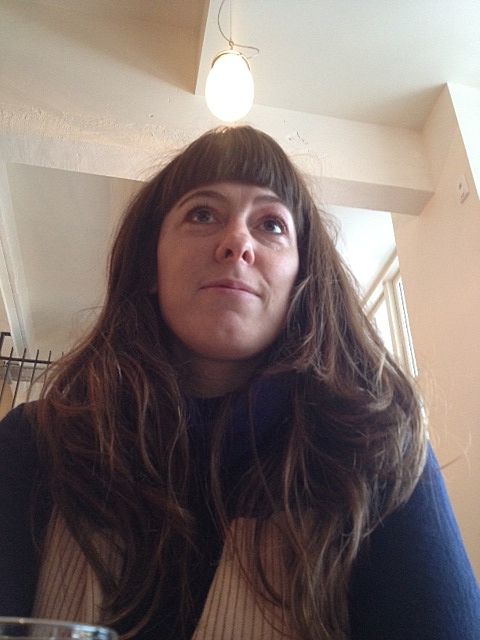Off the Dome: An Interview with Shannon Te Ao
Megan Dunn talks to the artist about his Walters win, cultural subcontracting, te reo and home.
Megan Dunn talks to the artist about his Walters win, cultural subcontracting, te reo and home.
two shoots that stretch far out is a work that fells you with feeling. Shannon Te Ao reads a waiata to animals. A Song of Two Wives is a lament written by a Ngāti Porou woman in response to her husband taking a second wife. Her waiata is infused with grief. Te Ao recites it to rabbits, ducks, chickens, a wallaby, a swan and finally a donkey. His words fall on deaf ears.
But not in the art scene. In 2016, two shoots that stretch far out (2013–14) and installation okea ururoatia (never say die) (2016) won Te Ao the Walters Prize. Judge, Doyrun Chong said, ‘I would like to thank Shannon for helping me remember that a powerful work of art is sometimes created by an elegant formula of a simple gesture and repetitions.’
Shannon Te Ao is an artist of Ngāti Tūwharetoa descent. In 2009, he graduated from Elam with a BFA Honors and his work is grounded in performance. He began using cameras to document his early action-based performances. In Follow the party of the whale (2012) he walks barefoot in a circle, a blanket draped over his shoulders. He bends down and picks up one of the plastic bottles of water arranged in the circle, and drinks, only to spout the water out. Again and again. Follow the party of the whale conjures an out of body experience, as Te Ao imagines the Parihaka prisoners on their journey to Dunedin, where many will die in jail, some without even standing trial. For Te Ao this work was about exploring and understanding the on-going mistreatment of Māori within Aotearoa.
“I was thinking about activism” he says, “is performance art futile in relation to actual political change? Alongside the history of Te Whiti and Tohu, the Parihaka movement and Maori activists today, sometimes our practice is a bit dumb.”
We sit in an open white studio at Massey University, where he teahes, the students are on holiday, and sunlight floods the windows. He is editing a new work comissioned for the Edinburgh Festival and is the only New Zealand artist to be included this year. Curated by Bruce E. Phillips, With the sun aglow I have my pensive moods continues Te Ao’s interest in whakataukī and waiata.
“Is your work about translation?” I ask, “More transportation,” he replies.
In person, Te Ao is amiable and good humoured, in contrast to his disquieting artworks. Space Gallery in Napier has just sent him a picture on Instagram of a new Dick Frizzell painting which references two shoots that stretch far out.
Megan Dunn: Do you think it is a homage or a critique?
Shannon Te Ao: It’s a weird square crop, of just the swan. It’s called Shannon’s Swan. It’s taken from the cover image of Anthony Byrt’s book This Model World.
MD: I didn’t think we were going to start at this point.
STA: Me either.
MD: Well, it is a good cover. In the last issue of Christchurch Art Gallery’s Bulletin, you told Nathan Pohio that anything you learn starts with a small hunch. What was the small hunch that led to two shoots that stretch far out?
STA: It started from wanting to play with that idea: what would happen if I tried to communicate a text to other animals? Over a few months, there were three different shoots, in various locations. That helped me test out different aspects of the project, like what location, what kinds of animal and how many, and what text to use. In the lead up, I wrote texts about domestic troubles—arguments, break ups, and make-ups. But in the end I used that waiata. My core interest is what those words carry.
MD: So, did you then look at the early footage and think, ‘no, that’s not it’?
STA: Yeah. One of the earlier shoots was on a dairy farm in Dunedin. We were in a paddock of horses. The landscape was too expansive. Some of those early test works were also opportunities to try different texts out and just go off the dome.
MD: You ended up shooting it in a barn in Waikanae. Did you visit the barn prior to filming?
STA: I had looked at a few farms. I went out to Hero Animals, a small commercial dairy farm, and met Caroline and James. They trade in horses and work in the film industry as animal trainers. But it was the building I was interested in. It had been relocated from Featherston POW camp. Its residual unease cemented my interest. In the end, most of the footage was captured in one afternoon.
It was also about being inside. It changes the way that you talk, how you project your voice. For me, animals are pretty much an outside thing.
MD: So, their energies were harder to contain outside?
STA: For sure, though those animals are more familiar with that particular interior space than I was or ever will be. But there is still a surreal foundation to the interaction, because the animals feel big because of the scale of the space.
MD: Do you have a bloopers reel?
STA: Of course. One of the things for me is balance. If I’m reading poetry to animals, that’s an incredibly corny image for a lot of people. I know that. And that’s often the bottom line in terms of what I will include, if something’s going to tip the scales …
MD: … into laughter?
STA: Yeah, or parody, or earnestness. Although, to me the works are incredibly earnest. I’m looking for conviction. I want viewers to sink into the performance, not roll their eyes.
MD: And it was always introduced species you wanted to film?
STA: Yeah, that was all we shot. There are flashier exotic animals up there, but it wasn’t about that for me. I wanted a group of companions in the work that were not so startling.
MD: Flashier animals would take it some place else.
STA: It’s not a Michael Jackson video.
MD: And it was commissioned for the Sydney Biennale.
I was questioning what it meant to have that as a model of success, and to have that model of success become canonical.
STA: Yeah. I met the curator Juliana Engberg at the Museum Hotel. I saw people we would both recognise coming out after having their meetings with her. She must have been about halfway through her second day of meetings, and I was like, ‘Hi Juliana, I’m Shannon, blah blah blah, nice to meet you.’ She was typing away, maybe some notes or an email and she said, ‘you have one hour’. So, we were part way through, and she’s says, ‘What else you got?’, and I was like, ‘Phwoar, that’s pretty rough’. But, on the off chance I’d put these A4 printouts of text works into my backpack, and I pulled those out. That was the starting point for Two Shoots and the conversation just kind of rolled on from there. In the context of the last few years, that work has been huge for me. Her commitment to that commission is why it got made.
MD: It won you the Walters Prize. How did you celebrate? Did you have a speech prepared?
STA: I didn’t. As soon as you find out you’re nominated, you go, ‘I’m not going to win, I’m not going to win’, and that’s all you think for four months to maintain some sanity. On the night, people were happy for me. The other artists were releasing after having been pent up. Everyone gets a free pass to decompress. By Saturday afternoon all my formal duties were done and we sat around and had a BBQ.
MD: When did you start working with Iain Frengley as your cinematographer?
STA: The first thing we made we’ve never shown, and I will never show it. The first work we exhibited was Untitled (McCahon House Studies) (2012).
MD: How prescriptive are you? And how prescriptive is he?
STA: Iain is my brother-in-law, but it’s not why we work together. He graduated from Otago with a Masters in Science, Communication, and Natural History Filmmaking – it’s a highly regarded documentary-making course. He was feeling bound by the conventions he’d learnt on that course, and was interested in exploring different ways of telling stories. I had been out of art school for a few years and wanted to explore some other things, performance-wise. I have no film training. That informs how we work with each other. It’s pretty intuitive. I’ll create the context for a shoot and then we’ll meet at the place and start developing the footage from there. It’s generally just the two of us and the thing we’re capturing, so it’s small scale. That’s the only way I’m interested in working at the moment.
MD: Untitled (McCahon House Studies) is a pretty nutty work, that involves you performing a series of erratic tasks at McCahon House. What’s with the dressing gown and the wig?
STA: I actually wore the dressing gown driving to the place on the day. It’s Kate’s, and I used it because I hated it. It’s this disgusting thing. I thought if I used it I might trash it or lose it, but I did neither and she still wears it. Her mum gave me a matching brown one and I just felt it to be this shroud of indignity.
MD: So why did you wear it to McCahon House? What was that about?
STA: On a simple level, it was ensuring that I’m not me, or not only me. It wasn’t about representing Kate, but bringing that part of my life into the physical experience of my making.
MD: The idea of a wife or caretaker?
STA: A caretaker or a custodian. I made that work because I was really questioning that way of working as an artist. I’m referring to the romanticised McCahonesque personality, being alienated from everyone and everything and locking yourself in the studio, and dredging up that shit for every painting. I was questioning what it meant to have that as a model of success, and to have that model of success become canonical.
MD: When were you introduced to McCahon’s work?
STD: At art school. Leading up to making that work, I read more about him, so I was aware how troubled the house context was, his alcoholism, the really tough conditions that the family was living in, all that stuff. I’m interested in managing the other parts of my life alongside my art practice, so I thought he was an interesting person to think about. I lived ten minutes down the road at that time and I didn’t think I would ever be an artist accepted for a residency. So I made my anti-residency artwork, maybe my anti-studio artwork.
MD: a torch and a light (cover) (2015) is filmed in an empty abattoir. Did you see a relationship between the abattoir and the animals in Two Shoots?
STA: Of course. I often respond to the work I’ve just made. If you look at my stuff you get a sense of that, but it’s not like I was setting out to make the gritty black-and-white version of two shoots.
MD: In this work you are shown performing some strange sculptural process with towels. What’s with the towels?
STA: It was a material I could relate to, but not control; a material that would help me engage in a kind of entanglement. So, for me, the action with the towels is about this physical, tangible process. I’m disappointed that they’re boiling hot towels, but the steam isn’t present, probably to the benefit of the work.
MD: I read John Hurrell’s Eyecontact review of a torch and a light (cover). He speculates that you’re trying to sculpt a dog or a lion with the towels. Are you trying to shape an actual form?
STA: Yeah, I was. I have a nickname for it, but I refuse to say it because everyone will call it that from now on.
MD: A cheap question. What does your twitter handle shaysmule mean? Is it a reference to Chester, the mule in Two Shoots?
STA: I made up that nickname for myself at art school. It’s a total tribute to P. Mule.
MD: Was P. Mule an important tutor to you at Elam?
STA: Was and still is. I’ve always respected her as an artist. Personality-wise, we are quite different. But I really appreciate the way she presents her work. It’s always measured and considered and those are traits that I’m trying to grow into.
MD: You did your BFA a bit late in life, right?
STA: Yeah. I was about 31 when I finished. I hadn’t studied before. I’m the first person in my family that went to university.
MD: Did you grow up speaking Māori?
STA: Not at all, and it’s something I’m still growing into.
MD: When did you start learning?
STA: About ten years ago. You know I was born in Sydney, I grew up and went to school there. I moved back to New Zealand permanently when I was about 25 or 26.
MD: Do you have family here?
STA: My Dad’s side of my family are here. When I was 7, he died in a house fire in Sydney. I’ve been thinking about it this week, because I’ve just been up in Taupo. That’s where we’re all from and where he’s buried.
MD: Do you remember him well?
STA: The memories I have of him are real and totally unique to a son. But can I remember details of conversations? Not really. I remember trips in the car, things like that. That’s not what my work is about. But it has informed the work. We weren’t in the house at the time he died. Him and Mum had split up by then. I remember the knock on the door at our place, getting woken up in the middle of the night, and what that entails. I’m happy to talk about it. No one really asks me about it. I don’t know why people don’t talk about it more. They do talk about the Australian thing.
MD: For me, a lot of your recent moving-image works evoke that feeling of being at a wake or a funeral. There’s a kind of fraught intimacy.
STA: ‘What do I remember of my Dad?’ That's an interesting question to think about in relation to my work. Some of the work evokes that kind of energy. This kind of wake-like space is very tangible to me right now, having just come back from a tangi.
MD: Untitled (malady) (2016) shows two women dancing, in an embrace. It refers to a famous scene from Charles Burnett's film, Killer of Sheep (1978). In the film, a husband and wife dance to Dinah Washington singing ‘This Bitter Earth’. Your piece contains no music but is titled after Te Rohu’s waiata, ‘A Song for a Leperous Malady’. What relationship do you see between Burnett’s film and Te Rohu’s waiatia, ‘A Song for a Leperous Malady’?
STA: It’s from a suite of waiata from the mid-1800s that draw out Te Rohu's whakapapa. It refers to the death of her father Te Heuheu Tukino in a landslide in 1846. I was drawn to it because it took that experience into an acute embodied moment. I’m related to that history—Te Rohu is a significant Ngati Tuwharetoa elder. Her waiata is about a personal, physical, highly emotional experience, but it originates from a physical affliction – leprosy. Yet, it’s her wish that her leprosy be understood within the context of the landslide. Burnett’s film and Te Rohu's waiata do similar things. They’re both grounded in intimate relationships but reach out to the social politics of their times. I see a relationship between the ambitions of the waiata and of Killer of Sheep, which takes place during the civil-rights movement. In Burnett’s dance scene, Stan rejects his wife. It’s a gut wrenching moment. It seemed like an entry point that just revealed itself.
MD: Why did you replace the husband and wife with two women?
STA: At the end of the slow dance scene in Burnett’s film Stan eventually rejects his wife’s advances, leaving her distraught in the living room. Untitled (malady) picks up on this moment as the opportunity to generate imagery in response to an imagined meeting between Te Rohu and Stan’s wife, who coincidentally in the context of Killer of Sheep remained un-named.
MD: Your new work for Edinburgh, With the sun aglow I have my pensive moods, takes its title from another line in Te Rohu’s waiata.
STA: I’m trying to dig into the space that Malady opened up.
MD: Where is it filmed?
STA: A bunch of places: a hemp farm in Ashburton, in the Desert Road, and the surrounding farms that encircle the Urupa where my Dad is buried. The work is still fresh.
MD: What’s the soundtrack?
STA: The dancing scene was shot in complete silence, apart from their breathing and footsteps. Within the installation, I have overlaid a soundtrack generated from a heavily processed vocal recording and some electronic instrumentation.
MD: Is ‘A Song for a Leperous Malady’ read out in this work?
STA: A passage has crept in, in addition to the ‘score.’.
Burnett’s film is told in vignettes, leaving interesting gaps. That relates to the things that I’ve been making too.
MD: With your interest in text and poetry, it’s natural to be attracted to the vignette. The waiata translations have a formality. Words like ‘malady’ aren’t in common use, and have a stately quality. Do you appreciate the texts more in te reo or in translation?
I appreciate the ‘stately-ness’ that te reo can enable. It’s not how we speak to each other in the workplace or down the street. It is used within formal Māori settings for sure, but I would also advocate for its normalcy. I’m really interested in trying to understand the world through these filters, not because I’m into lofty language, but it describes us in different kinds of ways. That kind of language is useful, because it can help you manage some hardcore shit. So sometimes, without those words, you can’t get through tangi or whatever.
MD: Your work in Artspace’s group show Politics of Sharing was the song ‘This Bitter Earth’ translated into te reo? Each translation was presented as a framed document: white text on a black background.
Yeah, and that project is on-going. The Artspace work Tēnei ao kawa nei, tēnei one kawa, tēnei ao kawa nei was made in response to an invitation from Daniel Maier-Reimer, a German artist. His works are long walks. In 2015, he came to New Zealand and walked from Christchurch to Auckland. Afterwards he documents the process with a single image and that image becomes the invitation for another artist’s response. Initially, when I met him, I liked the romance of his project, but I was quite sceptical of his secondary proposition, as if it was some kind of cultural subcontracting. I think the outcome at Artspace relays that ambivalence. I had three translations commissioned and three people—in Wellington, Christchurch, and Auckland, along the same route as Maier-Reimer’s journey—were invited in to respond quite freely. I saw them as advocates for te reo. Engaging people that can use his journey and understand this place through te reo, that’s different than just walking around.
MD: ‘This Bitter Earth’ translated into te reo reminds me of Johnny Cash doing Nick Cave. It’s so right, but we’re used to it going the other way.
What was the catalyst for you to learn te reo?
STA: Having kids, for sure. I had to up the ante, a bit. I’m pretty resigned to the fact that I’ll be in lessons for the rest of my life and that’s okay. For us, having Maori kids in New Zealand means that I want them to have those skills and enjoy what is great about who they are, and that's consolidated our whanau.
I feel my own difference being acknowledged all the time.
MD: Let’s cut over to your more recent Artspace show and talk about the new work, Te Huka o te Tai. This moving image work has two components: a panning shot of a forest/jungle landscape and then a long sequence of an artist creating a drawing. Where’s the landscape footage shot?
STA: Qixing Mountain, in a national park about two hours north from Taipei City. Pacific Studies teaches us about the genealogical link between Taiwanese indigenous people and Maori. I was thinking about that while I was there. Getting over there and seeing the landscape and the realities of how indigenous discourse is struggling in completely different but relatable ways to New Zealand, I began thinking about ‘te huka o te tai’, a line from a waiata about Taupo, which relates to some similar geothermally charged lands that I’m from.
I wanted to make a work that would ask how things are maintained and how things are, in the end, completely transient. The narrative is simply about going from the bottom to the top of the mountain, the highest peak in Taipei. All the camera does is go from the bottom to the top, and along the way you are invited to consider different geographical environmental details alongside an audio track. Deep down, there’s a vocal recording I made that refers to a singing tradition in Taipei composed purely from phonetics. There are no lyrics, just sounds.
MD: It’s very intense, absorbing. Who is the person drawing?
STA: A local artist, Tsai Wan Che. She’s filmed in the alley in front of the Taipei Contemporary Arts Center. Like a torch and a light, it’s about two different temporalities. I was interested in capturing something that was in a human kind of time zone. The landscape is as old as the earth, whereas the drawing embodies our fleeting impact on the place.
MD: Is language a place where people find home?
STA: Yeah, I think Māori articulate their sense of home through te reo. I work with so many students who don’t have te reo – for a number of reasons that’s their reality – but I would never try to say that we weren’t missing out on something. You can’t speak Maori without it.
MD: Do you feel the presence of racism in your life a lot?
STA: I do. I feel my own difference being acknowledged all the time. Within an art context, I’m certainly treated differently because of who I am, and I know my work is as well. Sometimes that’s positive, sometimes it’s not.

